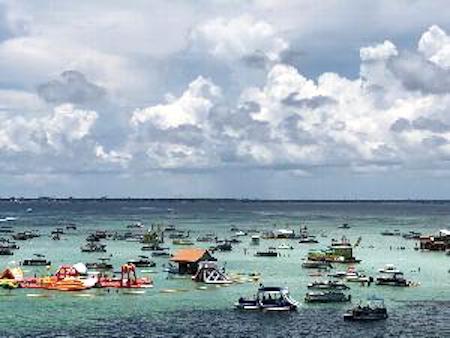
Gulf Islands National Seashore staff is thinking of implementing a commercial services strategy for "Crab Island," which at times looks like a party island/NPS file
Can there be too much of a good thing in the National Park System? There just might be at a patch of sand and water in Gulf Islands National Seashore in Florida, where its growing popularity is leading to adverse impacts on Gulf of Mexico fisheries and deadly accidents.
"Crab Island" is really just a large submerged sandbar near the William T. Marler Bridge on the eastern end of Santa Rosa Island; it serves as a vital nursery area for Gulf of Mexico fisheries and has been identified as a critical resource in the national seashore. But in recent years it has also turned into a floating party site.
"The Crab Island area has become a highly popular recreational site, drawing hundreds of boats and numerous floating commercial services such as restaurants, water taxis, and mobile small craft vendors which traverse and anchor within the sandy and seagrass portions of the sandbar," according to Gulf Islands staff. "The popularity of the sandbar has led to issues of concern shared by the National Park Service, state and local governments, agencies, and other stakeholders. These issues include life-threatening accidents and fatalities, damaged seagrass beds, and diminished water quality."
To deal with the situation, the park wants to come up with a commercial services strategy for Crab Island. Between 2002 and 2014, the Park Service developed a General Management Plan for the entire national seashore with extensive public input. The GMP designates specific management zones and details how it would manage Gulf Islands as an outdoor classroom for exploring the natural and human history of the Gulf of Mexico’s barrier islands and coastal environments.
The GMP designated the Choctawhatchee Bay portion of the national seashore, where Crab Island is located, as a mix of a “Natural Settings with Dispersed Recreation” zone and a “Seagrass Bed” zone. As such, the area is to be managed "to prevent resource damage to seagrass beds from vessel groundings, anchoring, and propeller scarring."
"Life-threatening accidents and fatalities in this area are common," the seashore staff notes. "Crab Island is located immediately adjacent to East Pass, which connects Choctawhatchee Bay and the Gulf of Mexico. When the tide goes out, it creates a strong current that can drag those standing in the shallow Crab Island waters into the deeper waters of East Pass channel and the Gulf. Multiple drownings occur at Crab Island each summer.
"Between Memorial Day and Labor Day weekends, hundreds of visitor incidents include marine DUI, disturbances and altercations, boating and personal watercraft accidents, boat fires, medical emergencies, swimmer assists and rescues, and fatalities," they add.
In a bid to reduce this trend, seashore staff is moving into a formal planning process to determine the level of commercial activity at Crab Island that is consistent with the national seashore’s General Management Plan, federal law and regulations, and local laws and ordinances. Now park staff wants to hear from stakeholders for input regarding the commercial services stratgey and the preliminary options that have been developed.
Gulf Islands National Seashore has developed the following suite of preliminary Reasonable Alternative Concepts representing commercial service strategies which could be employed by the NPS to meet the needs of the park while addressing the concerns of local government and the public:
Alternative Concept #1: Fully Implement the Commercial Services Strategy (CSS).
• Implements the Commercial Services Strategy for Crab Island
• NPS would issue CUAs for compliant commercial services
• Compliant with GMP Zones
• Compliant with the Necessary and Appropriate (N&A) Criteria of the CSS
• Supports actions for maintaining and/or restoring the natural and human environment to the desired resource condition as defined in the GMP-EIS Record of Decision (ROD).Alternative Concept #2: No Authorization of Commercial Services (No CUAs)
NPS would NOT issue CUAs for compliant commercial services
• safety issues associated with the proximity of the East Pass and the subsequent strong currents during tidal exchanges
• natural resource impacts due to the location within the Seagrass Bed Zone
This alternative concept would be:
• Compliant with GMP Zones• Compliant with the Necessary and Appropriate (N&A) Criteria of the CSS
• Supports actions for maintaining and/or restoring the natural and human environment to the desired resource condition as defined in the GMP-EIS Record of Decision (ROD).
No Action Alternative Concept:
• Pre-2019 baseline of unauthorized and unpermitted commercial use activities when federal laws and regulations were not being enforced.This alternative concept would be:
• Non-Compliant with GMP Zones
• Non-Compliant with the Necessary and Appropriate (N&A) Criteria of the CSS• Non-Compliant with local ordinances
You can learn more about the process at this site.



Comments
Thank you for getting rid of all the commercial activity out there
I am not sure why the apparent sudden interest by NPS to help with managing Crab Island. I worked at GUIS as District Ranger from 1986 to 2000 and the subject of Crab Island's managment never came up. I certainly hope that NPS does not take an active role in enforcing water safety and water quality issues because GUIS barely has enough staffing to operate the rest of the park. Crab Island has one of the highest concentrations of recreational boats in NW Florida and it requires regular enforcement by USCG, Okaloosa County Sheriff's Office, and State of Florida Fish and Wildlife Officers. If NPS wants to offer expertise on issuing commercial use licenses and managing sea grass beds, I think that this would be a suitable role but I recommend that it stays out of the enforcement side.